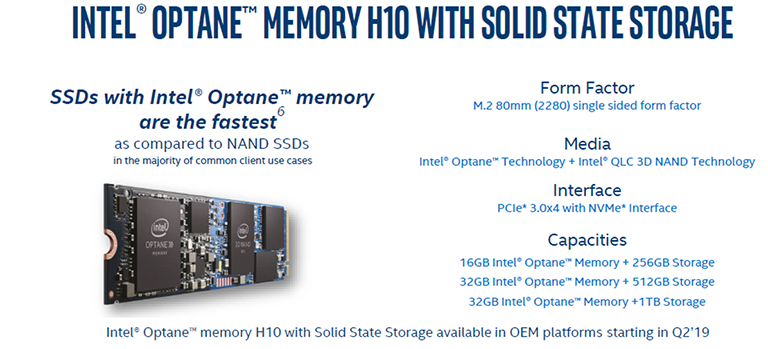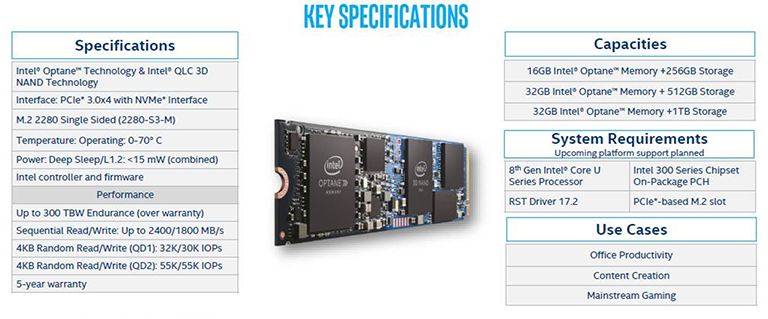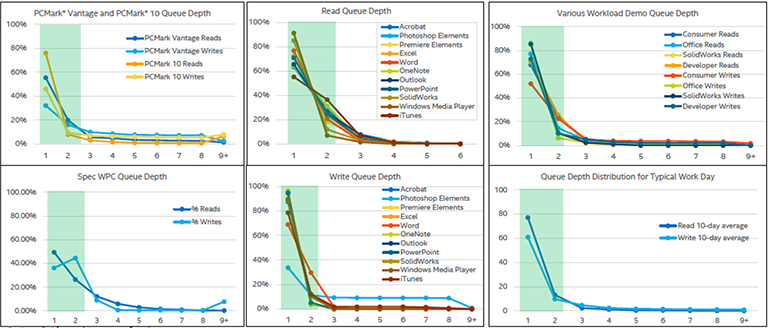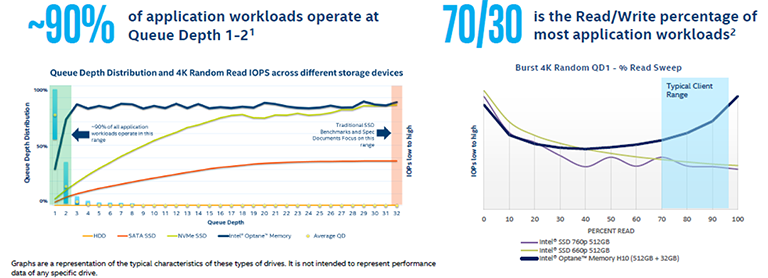Back at CES 2019, Intel unveiled a new class of hybrid solid-state storage that combines two of its leading technologies: Optane and QLC NAND. The resultant drive is known as Optane Memory H10, and Intel took a bit of time last week to flesh out some of the higher-level details. Destined for upcoming laptops from the big boys - Dell, HP, Acer, Asus, et al - Intel affirmed that it has no plans to bring it to the DIY market anytime soon. Shame, that.
The purpose of Optane Memory H10 is to present a very fast front-end for caching frequently-used data, with the remaining QLC NAND providing slower, general-purpose storage support for data not as frequently used. What's interesting is that the QLC NAND itself has a faster portion of SLC memory for its own caching, so Intel sees logical data progression as Optane - SLC - QLC.
Intel, however, isn't doing anything revolutionary here. The 16GB or 32GB Optane part of the drive is, for all intents and purposes, the same as the Optane-only model that's been in the market for a while now, whereas the QLC NAND is budget-friendly 660p NVMe by another name. It's the mating of the two, ostensibly for laptops that feature only a single M.2 slot, that's newsworthy here.
Optane Memory H10 needs a PCIe 3.0 x4 interface to the host system. The Optane and QLC NAND both have their own PCIe 3.0 x2 controllers to the motherboard. Communication between the drive and system is taken care of by Intel's Rapid Storage Technology 17.2 software, and the understanding is that only the QLC NAND portion will be visible to the operating system.
Looking at numbers, Intel quotes maximum sequential throughput as 2,400MB/s read and 1,800MHz write, which is more than the x2 link can service. Intel says that, with RST at the helm, it uses intelligent bandwidth aggregation to funnel more data - concurrent reads/writes from both SSDs - than would ordinarily be possible.
It is normal for manufacturers to quote the maximum 4K random read and write speeds with a deep queue depth of 32 concurrent users, and this is how most modern SSDs function at their best. A large part of the reason for the Optane Memory H10's existence is born from the research that Intel has done at understanding the real queue depth for consumer workloads.
To this end, it reckons that the vast majority of productivity-based apps use a queue depth of either one or two - three at a push - and it is in this scenario that drives need to excel. Massive QDs are the preserve of the server market, the company intimates.
What Intel is reiterating here is that Optane's 3D XPoint characteristics are well-suited to low queue depths, offering performance that's comfortably head and shoulders above regular NVMe drives. Having this Optane as a front-end, as the H10 employs, effectively turbocharges the existing 660p NVMe SSD in everyday tasks.
Just what kind of benefit is accrued over a regular 660p or, say, high-performance WD Black NVMe SN750 was not discussed, but we're eager to get an Optane Memory H10 hybrid drive in and see if it can separate the wheat from the chaff.
Elevating SSD performance by using Optane makes sense only insofar as costs can be kept in check. Optane, by definition, is not a cheap technology to produce, and lumping 32GB on a 512GB QLC drive won't be cheap. And doesn't it make more sense to run Optane with faster TLC NAND instead of QLC? Interesting question.
If Optane Memory H10 turns out to be as expensive as a premium NVMe drive on a same-capacity basis then we have to wonder what the fuss is about. Only time will tell, and thankfully we don't have long to wait.

















